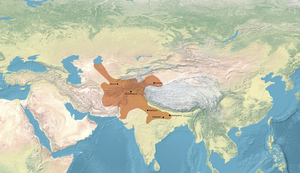[[
Pax Kushana or Pax Kushanica (Latin for "Kushan Peace", modelled after Pax Romana ) is a historiographical term sometimes used to describe the social and economic peace in the regions under the Kushan Empire between 2nd and 4th centuries AD, notably in the Indus Valley, Gandhara and parts of Central Asia. [1] [2]

